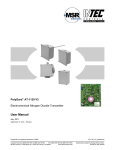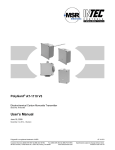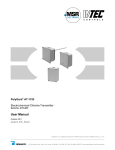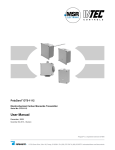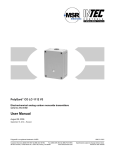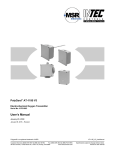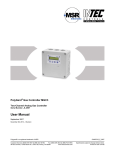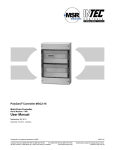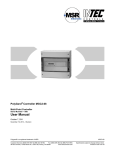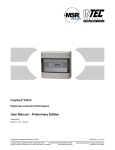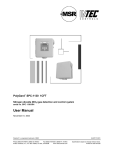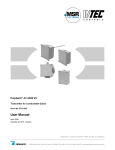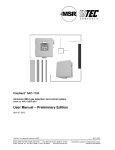Download User Manual - INTEC Controls
Transcript
PolyGard AT-1125 V3 Electrochemical Ammonia Transmitter Serial No. AT03-005 User Manual December 2013 September 15, 2014 – Revision Polygard® is a registered trademark of MSR Customer Services (858) 578-7887 & (888) GO INTEC Fax (858) 578-4633 & (888) FX INTEC www.inteccontrols.com INTEC Controls, 12700 Stowe Dr., Suite 100, Poway, CA 92064 GAADT231125_E.pdf Specification subject to change without notice. Printed in USA 140915 PolyGard® NH3 Gas Transmitter User Manual - AT-1125 V3 Page 02 1 Intended Use ..........................................................................................................3 2 Functional Description .........................................................................................3 2.1 2.2 3 Installation .............................................................................................................4 3.1 3.2 4 Mounting Instructions .............................................................................................................. 4 Installation ............................................................................................................................... 4 Electrical Connection............................................................................................4 4.1 5 Control Mode .......................................................................................................................... 3 Sensor ..................................................................................................................................... 3 Wiring Connection................................................................................................................... 4 Commissioning .....................................................................................................5 5.1 Correction of the Zero-point at the Analog Output Signal ...................................................... 5 5.2 Manual Calibration .................................................................................................................. 5 5.2.1 Zero-point ............................................................................................................................ 5 5.2.2 Gain ..................................................................................................................................... 6 5.2.3 Calculation of Control Voltage............................................................................................. 7 5.3 Option Relay Output ............................................................................................................... 7 6 Service and Inspection .........................................................................................8 6.1 6.2 6.3 7 Inspection ................................................................................................................................ 8 Service and Calibration ........................................................................................................... 8 Exchange of Sensor Element ................................................................................................. 8 Troubleshooting ....................................................................................................9 7.1 Analog Mode ........................................................................................................................... 9 8 Cross-sensitivity Data......................................................................................... 10 9 Technical Data ..................................................................................................... 11 10 Figures ................................................................................................................. 13 11 Part Disposal ....................................................................................................... 15 12 Notes and General Information .......................................................................... 15 12.1 12.2 12.3 12.4 Intended Product Application ................................................................................................ 15 Installers’ Responsibilities..................................................................................................... 15 Maintenance ......................................................................................................................... 15 Limited Warranty ................................................................................................................... 15 Polygard® is a registered trademark of MSR Customer Services (858) 578-7887 & (888) GO INTEC Fax (858) 578-4633 & (888) FX INTEC www.inteccontrols.com INTEC Controls, 12700 Stowe Dr., Suite 100, Poway, CA 92064 GAADT231125_E.pdf Specification subject to change without notice. Printed in USA 140915 PolyGard® NH3 Gas Transmitter User Manual - AT-1125 V3 Page 03 Electrochemical Ammonia Transmitter 1 Intended Use The PolyGard NH3 analog transmitter AT-1125 with digital processing of the measured values and temperature compensation is used to detect leakages of ammonia in the ambient air. The sites intended for use are all areas being directly connected to the public low voltage supply, e.g. domestic, commercial and industrial ranges as well as small enterprises (acc. to EN 50 082). The PolyGard NH3 analog transmitter must not be used in potentially explosive atmospheres. The transmitter must only be employed in areas within the environmental conditions as specified in the Technical Data. 2 Functional Description 2.1 Control Mode The analog output can be selected as current signal with (0)4-20 mA or as voltage signal (0)2-10 V. In the 4-20 mA mode and without any supplementary options, the AT-1125 also works in the 2-wire technique. 2.2 Sensor The sensor portion of the transmitter is a sealed micro-fuel cell with three electrodes, sensing, counter and reference. The ambient air enters the cell through a diffusion barrier into the liquid electrolyte of the sensor. The chemical process of the measurement is one of reduction where one molecule of the target gas is exchanged for one molecule of oxygen. The reaction drives the oxygen molecule to the counter electrode, generating a DC microampere signal between the sensing and counter electrodes. This signal is linear to the volume concentration of the sensed gas. The signal is evaluated by the connected amplifier and transformed into a linear output signal. Electrochemical processes always lead by-and-by to a loss of sensitivity. Therefore regular calibration of the zeropoint and of the gain is necessary. See also section 6. Caution: There is a small quantity of corrosive liquid in the sensor element. If in case of damage persons or objects encounter the liquid, you have to clean the affected areas as fast and carefully as possible with tap water. Out of use sensors must be disposed in the same way as batteries. Polygard® is a registered trademark of MSR Customer Services (858) 578-7887 & (888) GO INTEC Fax (858) 578-4633 & (888) FX INTEC www.inteccontrols.com INTEC Controls, 12700 Stowe Dr., Suite 100, Poway, CA 92064 GAADT231125_E.pdf Specification subject to change without notice. Printed in USA 140915 PolyGard® NH3 Gas Transmitter User Manual - AT-1125 V3 Page 04 3 Installation Caution: Avoid any force (e.g. by thumb) on the sensor element during operation or installation. Electronics can be destroyed by static electricity. Therefore, do not touch the equipment without a wrist strap connected to ground or without standing on conductive floor (acc. to DIN EN 100015). 3.1 Mounting Instructions When choosing the mounting site please pay attention to the following: The specific weight of Ammonia, NH3, is lower than that of air (factor 0.59). Installation at the highest point possible with a distance of ca. 300 mm to the ceiling. Select the location of the sensor according to local regulations. Consider the ventilation conditions! Do not mount the transmitter in the centre of the airflow (air passages, suction holes) Mount the transmitter at a location with minimum vibration and minimum variation in temperature (avoid direct sunlight). Avoid locations where water, oil etc. may influence proper operation and where mechanical damage might be possible. Provide adequate space for maintenance and calibration work. Duct mounting Mount only in a straight section of duct with minimum air vortex. Keep a minimum distance of 1 m (3.5 feet) from any curve or obstacle. Mount only in a duct system with a maximum air velocity of 10 m/s (2000 ft/min) or less. Mounting must be performed so that the airflow is in line with probe openings. 3.2 Installation Open cover of enclosure. Unplug PCB from terminal blocks. Fix bottom part by screws vertically to the wall (terminal blocks to the ground). Re-plug the PCB at X4 and X5. Replace the cover. 4 Electrical Connection Consider static electricity! See 3. Mounting. Installation of the electrical wiring should only be performed by a trained specialist according to the connection diagram and according to the corresponding regulations, without any power applied to conductors! Avoid any influence of external interference by using shielded cables. Recommended cable for analog mode: J-Y(St)Y 2x2x0.8 LG (20 AWG), max. loop resistance 73 /km (20.8 /1000 ft). When the PBC is mounted, it is important to ensure that the wire shields or any bare wires do not short the PCB. 4.1 Wiring Connection Open cover of enclosure. Unplug PCB from terminal blocks X4 and X5. Enter cable through hole; connect cable leads to the terminal blocks. See fig. 1 and 2. Re-plug the basic PCB at the terminal blocks X4, X5. Close cover. Note. The connection of the power supply at the output signal (X4 pin 4) can destroy the transmitter. Polygard® is a registered trademark of MSR Customer Services (858) 578-7887 & (888) GO INTEC Fax (858) 578-4633 & (888) FX INTEC www.inteccontrols.com INTEC Controls, 12700 Stowe Dr., Suite 100, Poway, CA 92064 GAADT231125_E.pdf Specification subject to change without notice. Printed in USA 140915 PolyGard® NH3 Gas Transmitter User Manual - AT-1125 V3 Page 05 5 Commissioning Consider commissioning instructions at any exchange of sensor elements. Only trained technicians should perform the following: Check mounting location. Select output signal form: Current or voltage, and starting point 0 or 20%. See fig. 4. Check supply voltage. Check PCB for correct mounting at X4 and X5. Check sensor element for correct mounting at terminal X3 of the PCB. Calibration of the transmitter (if not factory-calibrated) Required instruments to calibrate the transmitter: Test gas bottle with synthetic air (20 % O2, 80 % N) or NH3-free ambient air. Test gas bottle with NH3 in the range of 20 to 70 % of the measurement range. Rest is synthetic air. Gas pressure regulator with flow meter to control the gas flow to 300 ml/min Sensor head calibration adapter with tube. Type calibration set AT1110SO1. See Fig. 5. Digital voltmeter with range 0 – 2 VDC, accuracy 1%. Screwdriver small. Note: Prior to calibration the sensor element must be fully stabilized by applying power voltage for at least 18 hours without interruption. Please observe proper handling procedures for test gas bottles according to TRGS 220! Attention: NH3 calibration gas is toxic, never inhale the gas! Symptoms at high concentrations: Loss of motility and consciousness. Procedure if exposed: Get the victim into fresh air at once, consult doctor. 5.1 Correction of the Zero-point at the Analog Output Signal The analog output signal is factory set to the zero-point. If necessary, a manual adaptation of the analog signal is possible within 10 sec. after having applied the supply voltage. Jumper 0-20 % for signal start has to be set (= 4 mA or 2 V). Connect digital voltmeter (300 mV) at test pint “Test” (measuring signal ~ 40 mV = 4.0 mA). Switch on the operating voltage. Each pressing on the “Zero” push-button increases the signal by + 0.5 mV (0.05 mA). Press the button repeatedly until the measuring signal reaches 40 ± 0.2 mV. After 44mV the signal starts again at 36 mV. The correction is only possible within the 10 seconds after having switched on the power supply. An impulse pause of more than 10 sec. cancels the release of the correction function. 5.2 Manual Calibration Manual calibration is only possible if the transmitter is equipped with the push-button “Zero” and the potentiometer “Gain” (= version for manual calibration). Manual calibration is possible both in analog mode and in DGC-05_Bus mode. In the DGC-05_Bus mode the jumper V-A has to be set before manual calibration. Only by doing so the control voltage is available at the test pins X6. Remove the jumper after calibration 5.2.1 Zero-point Connect digital voltmeter to pin “Test”. Connect the calibration adapter carefully to the sensor element. Polygard® is a registered trademark of MSR Customer Services (858) 578-7887 & (888) GO INTEC Fax (858) 578-4633 & (888) FX INTEC www.inteccontrols.com INTEC Controls, 12700 Stowe Dr., Suite 100, Poway, CA 92064 GAADT231125_E.pdf Specification subject to change without notice. Printed in USA 140915 PolyGard® NH3 Gas Transmitter User Manual - AT-1125 V3 Page 06 Apply zero calibration gas, (300 ml/min; 1 Bar (14.5psi) ± 10%), or other clean air source to the sensor element. Wait 3 minutes until the signal is about 40 mV and stable, then press the button Zero for 5 seconds. Finished! After successful calibration the measuring signal is corrected automatically. Depending on the selected signal starting point the measuring signal shows the following values: Signal start at 2 V or 4 mA 40 mV = 0 ppm Signal start at 0 V or 0 mA 0 mV = 0 ppm If the zero-point is out of the admissible range (> 20 mV at starting point 0% / > 60 mV at starting point 20%) before calibration, there is no correction of the measuring signal. The sensor has to be replaced. Remove calibration adapter carefully by turning lightly. Check the sensor for correct mounting! 5.2.2 Gain Connect digital voltmeter to pin “Test”. Connect calibration adapter carefully to the sensor element. Apply test gas NH3 (20 to 70% of range) to the sensor (300 ml/min; 1 Bar ± 10%) Wait 3 minutes until the sensor is stable, adjust signal with gain potentiometer ”Gain” until the signal corresponds to the calculated value ± 3 mV, see calculation section 5.3.3 and is stable. Remove calibration adapter with a careful light turn. Check the sensor for correct mounting! By limiting the gain factor, calibration will not be possible any more when the sensitivity of the sensor reaches a residual sensitivity of 30 %. Then the sensor has to be replaced. Polygard® is a registered trademark of MSR Customer Services (858) 578-7887 & (888) GO INTEC Fax (858) 578-4633 & (888) FX INTEC www.inteccontrols.com INTEC Controls, 12700 Stowe Dr., Suite 100, Poway, CA 92064 GAADT231125_E.pdf Specification subject to change without notice. Printed in USA 140915 PolyGard® NH3 Gas Transmitter User Manual - AT-1125 V3 Page 07 5.2.3 Calculation of Control Voltage Control voltage (mV) = 160 (mV) x test gas concentration NH3 (ppm) measuring range NH3 (ppm) + 40 (mV) Example Measuring range NH3 300 ppm 1000 ppm Test gas concentration NH3 150 ppm 300 ppm Control voltage 120 mV 88 mV 160 (mV) x 150 (ppm) + 40 (mV) = 120 mV. 300 ppm 5.3 Option Relay Output The two relays are activated in dependence of the gas concentration. If the gas concentration exceeds the adjusted alarm threshold, the corresponding relay switches on. If the gas concentration falls below the threshold minus hysteresis, the relay switches off again. The contact function for relay 2, NC (normally closed) or NO (normally open), can be selected via the jumper NO/NC. See fig 1 and 3. Relay 1 is equipped with a change-over contact. Via the ModBus interface the two alarm thresholds and the hysteresis are freely adjustable at the PC within the measuring range. The procedure can be read from the user manual “ModBus Software”. The following parameters are factory-set for measuring range 300 ppm: Alarm threshold 1 = Relay 1: 80 ppm Alarm threshold 2 = Relay 2: 250 ppm Switching hysteresis: 15 ppm Polygard® is a registered trademark of MSR Customer Services (858) 578-7887 & (888) GO INTEC Fax (858) 578-4633 & (888) FX INTEC www.inteccontrols.com INTEC Controls, 12700 Stowe Dr., Suite 100, Poway, CA 92064 GAADT231125_E.pdf Specification subject to change without notice. Printed in USA 140915 PolyGard® NH3 Gas Transmitter User Manual - AT-1125 V3 Page 08 6 Service and Inspection Inspection, service and calibration of the transmitters should be done by trained technicians and executed at regular intervals. We therefore recommend concluding a service contract with MSR or one of their authorized partners. According to EN 45544-4, inspection and service has to be executed at regular intervals. The maximum intervals have to be determined by the person responsible for the gas warning system according to the legal requirements. MSR-E recommends checking the PolyGard Transmitter every three months and maintaining it every 12 months. If different intervals are indicated, always consider the shortest interval. Inspections and services must be documented. The date for the next maintenance has to be affixed to the transmitter. 6.1 Inspection The PolyGard Transmitter should be controlled regularly by a competent person according to EN 45544-4. The following has to be checked in particular: Maintenance/ calibration interval not exceeded. Visual inspection of the transmitter including cable for damage etc. Remove dust deposits, especially at the gas inlet. The filter at the gas inlet has to be replaced if extremely dirty. 6.2 Service and Calibration When performing the maintenance you have to do the calibration and the functional test in addition to the inspection. Calibration: See section 5. Functional test: Check the output signal at the test pins during calibration. 6.3 Exchange of Sensor Element Consider static electricity! See point 3. Sensor should always be installed without voltage applied. Unplug basic PCB carefully from the terminal blocks on base. Unplug old sensor element from the PCB. Take new sensor element out of original packing. Plug in sensor element into the PCB at X3. Plug in carefully the PCB into terminal block X4, X5. Calibrate according to section 5. Polygard® is a registered trademark of MSR Customer Services (858) 578-7887 & (888) GO INTEC Fax (858) 578-4633 & (888) FX INTEC www.inteccontrols.com INTEC Controls, 12700 Stowe Dr., Suite 100, Poway, CA 92064 GAADT231125_E.pdf Specification subject to change without notice. Printed in USA 140915 PolyGard® NH3 Gas Transmitter User Manual - AT-1125 V3 Page 09 7 Troubleshooting 7.1 Analog Mode Trouble Cause Solution Output signal < 3 mA / 1,5 V and/or control voltage < 30 mV only for starting signal 2V/4 mA Jumper 0-20 % not set Check jumper position Measure tension at X4: Two-wire: Pin 1 (+) and 4 (-) Three-wire: Pin 1 (+) and 2 (-) Power voltage not applied PCB not plugged in correctly at X4 and X5 Replug PCB correctly Wire break Check the wiring Output signal > 22 mA /220 mV Short-circuit Check the wiring Control voltage does not reach the calculated value Sensor element not calibrated Sensor sensitivity < 30 % No reaction of the output signal in spite of gas concentration Power voltage not applied Signal (Pin 4) not wired correctly Calibrate sensor element Replace sensor element Measure tension at X4 Polygard® is a registered trademark of MSR Customer Services (858) 578-7887 & (888) GO INTEC Fax (858) 578-4633 & (888) FX INTEC www.inteccontrols.com INTEC Controls, 12700 Stowe Dr., Suite 100, Poway, CA 92064 Check the wiring GAADT231125_E.pdf Specification subject to change without notice. Printed in USA 140915 PolyGard® NH3 Gas Transmitter User Manual - AT-1125 V3 Page 10 8 Cross-sensitivity Data The table does not claim to be complete. Other gases can have an influence on the sensitivity, too. The indicated sensitivity data are only standard values referring to new sensor elements. Chemical formula Gas concentration Exposure time (min) Influence on the reading (ppm NH3) Chlorine CL2 10 ppm 5 0 Ethanol C2H6O 100 ppm 5 0 C2H4 1000 ppm 5 0 Carbon monoxide CO 200 ppm 5 0 Carbon dioxide CO2 5.000 ppm 5 0 Methane CH4 5.000 ppm 5 0 Hydrogen H2 1.000 ppm 5 < -10 (MB 100); <-150 (MB 300) Sulphur dioxide SO2 10 ppm 5 < 15 (MB 100); < 12 (MB 300) Hydrogen sulphide H2S 100 ppm 5 < 30 Nitrogen monoxide NO 20 ppm 5 < 2 (MB 100); 0 (MB 300) Nitrogen dioxide NO2 20 ppm 5 0 Gas Ethylene Polygard® is a registered trademark of MSR Customer Services (858) 578-7887 & (888) GO INTEC Fax (858) 578-4633 & (888) FX INTEC www.inteccontrols.com INTEC Controls, 12700 Stowe Dr., Suite 100, Poway, CA 92064 GAADT231125_E.pdf Specification subject to change without notice. Printed in USA 140915 PolyGard® NH3 Gas Transmitter User Manual - AT-1125 V3 Page 11 9 Technical Data General sensor performances Gas type Sensor element Measuring range Pressure range Humidity Storage temperature range Storage time Accuracy Repeatability Zero point drift Long term output drift Response time Temperature range Life expectancy Electrical Power supply Power consumption (without options) - Analog mode Output signal Analog output signal Selectable: Current / tension Starting point 0 / 20 % Physical Enclosure Plastic, Type "A" Flammability Enclosure colour Dimensions (W x H x D) Weight Protection class Mounting Enclosure Galvanized Steel, Type "0" Enclosure colour Dimensions (W x H x D) Protection class Mounting Cable entry Wire connection Wire distance Ammonia (NH3) Electrochemical, diffusion 0 - 100 ppm / 0 - 300 ppm / 0 - 1000 ppm Atmosphere ± 15 % 15 – 90 % RH non condensing 5 °C to + 30 °C (41 °F to 86 °F) Max. 6 months ± 30 ppm (range 300 / 1000 ppm) ± 5 ppm (range 100 ppm) ± 10 % of reading < ± 50 ppm /year (range 300/ 1000 ppm) < ± 10 ppm /year (range 100 ppm) 2 % measured value/month t90 120 s (range 300 / 1000 ppm) t90 90 s (range 100 ppm) -10 °C to + 50 °C (14 °F to 122 °F) w/o heating > 2 years/normal operating environment 18 - 28 VDC/AC, reverse polarity protected 22 mA, max. (0,6 VA) (0) 4 – 20 mA, load 500 , (0) 2 - 10 V; load ≥ 50 k proportional, overload and short-circuit proof Polycarbonate UL 94 V2 Light gray RAL 7032 94 x 130 x 57 mm (3.7 x 5.12 x 2.25 in.) Approx. 0.3 kg (0.7 Ib.) IP65 Wall mounting Galvanized steel w/zinc coating Light gray 113 x 135 x 45 mm (5.35 x 4.5 x 1.8 in.) NEMA 1 (IP42) Wall (surface) mounted, or single gang electrical box Standard 1 x M 20 Screw-type terminal: 0.25 to 2.5 mm2 24 to 14 AWG Current signal ca. 500 m (1500 ft.) Voltage signal ca. 200 m (500 ft.) Polygard® is a registered trademark of MSR Customer Services (858) 578-7887 & (888) GO INTEC Fax (858) 578-4633 & (888) FX INTEC www.inteccontrols.com INTEC Controls, 12700 Stowe Dr., Suite 100, Poway, CA 92064 GAADT231125_E.pdf Specification subject to change without notice. Printed in USA 140915 PolyGard® NH3 Gas Transmitter User Manual - AT-1125 V3 Guidelines Warranty Relay output Alarm relay 1 Alarm relay 2 Power consumption Heating Temperature controlled Ambient temperature Power consumption Page 12 EMC Directive 2004/108/EC EN 61010-1; 2010 ANSI/UL 61010-1 CAN/CSA-C22.2 No. 61010-1 CE Two years material and workmanship, 12 months normal exposure for sensor element Options 30 VAC/DC 0.5 A, potential-free, SPDT 30 VAC/DC 0.5 A, potential-free SPNO/SPNC 30 mA, (max. 0.8 VA) 3 °C ±2 °C (37 °F ± 4 °F) - 40 °C (-40 °F) 0.3 A; 7.5 VA Polygard® is a registered trademark of MSR Customer Services (858) 578-7887 & (888) GO INTEC Fax (858) 578-4633 & (888) FX INTEC www.inteccontrols.com INTEC Controls, 12700 Stowe Dr., Suite 100, Poway, CA 92064 GAADT231125_E.pdf Specification subject to change without notice. Printed in USA 140915 PolyGard® NH3 Gas Transmitter User Manual - AT-1125 V3 Page 13 10 Figures Do not connect power supply at this pin. (0 VDC, 24 VAC or 0VAC will destroy the transmitter.) Controller 4-20 mA 24 V 0V 7 Bus_B 6 Bus_A 5 4-20 mA_Inp 4 Analog_Out 3 24 VDC_Out 2 0V 1 24 VDC X4 Transmitter AT-1125 Controller 1 2 3 4 5 X5 4-20 mA 24 V 0V Two-wire connection - 4 - 20 mA output signal without Option 7 Bus_B Relay 6 Bus_A 1 5 4-20 mA_Inp R1 2 4 Analog_Out 3 3 24 V_Out 4 2 0V 5 1 24 VAC/DC R2 X4 X5 Transmitter AT-1125 NO NC Application: Analog mode Fig. 1 Three-wire connection - VDC output signal - 0 – 20 mA output signal - Relay output - LCD display - Heating options Do not connect 24 VAC at pin 2 and pin 4 or +24 VDC at pin 2 and 0 VDC at pin 4!! Short-circuit = R 10 Ohm burns up!! Analog_Out 0 VAC/DC 24 VAC/DC Polygard® is a registered trademark of MSR Customer Services (858) 578-7887 & (888) GO INTEC Fax (858) 578-4633 & (888) FX INTEC www.inteccontrols.com INTEC Controls, 12700 Stowe Dr., Suite 100, Poway, CA 92064 5 10 Ω 4 3 2 1 X4 Transmitter AT-1125 GAADT231125_E.pdf Specification subject to change without notice. Printed in USA 140915 PolyGard® NH3 Gas Transmitter User Manual - AT-1125 V3 Page 14 PCB Fig. 3 Terminal block Anal. Ouput Start Point = 20 % =0% V-A 2 1 X4 Sensor XA3-2 XA3-1 = NO = NC 1 2 3 4 X5 5 Option Relay R2 R1 3 NO NC Test 4 X5 NO/NC 5 Function Relay R2 Zero 6 1 2 3 4 5 6 7 Gain 0-20% 7 1 2 3 4 5 Manual Calibration X4 Anal. Output = V DC = mA Selection analog output signal Fig. 4 Jumper 0- 20 % Jumper V-A Output signal Not set Not set 0 – 20 mA Set Not set 4 – 20 mA Not set Set 0 – 10 V Set Set 2 – 10 V Calibration adapter Fig. 5 Type: CONKIT-E/CH-LC Polygard® is a registered trademark of MSR Customer Services (858) 578-7887 & (888) GO INTEC Fax (858) 578-4633 & (888) FX INTEC www.inteccontrols.com INTEC Controls, 12700 Stowe Dr., Suite 100, Poway, CA 92064 GAADT231125_E.pdf Specification subject to change without notice. Printed in USA 140915 PolyGard® NH3 Gas Transmitter User Manual - AT-1125 V3 Page 15 11 Part Disposal Since August 2005 there are EC-wide directives defined in the EC Directive 2002/96/EC and in national codes concerning the waste electrical and electronic equipment and also regarding this device. For private households there are special collecting and recycling possibilities. For this device isn’t registered for the use in private households, it mustn’t be disposed this way. You can send it back to your national sales organisation for disposal. If there are any questions concerning disposal please contact your national sales organisation. Outside the EC, you have to consider the corresponding directives. 12 Notes and General Information It is important to read this user manual thoroughly and clearly in order to understand the information and instructions. The PolyGard® transmitters must be used within product specification capabilities. The appropriate operating and maintenance instructions and recommendations must be strictly followed. Due to on-going product development, MSR-Electronic-GmbH and INTEC Controls reserve the right to change specifications without notice. The information contained herein is based upon data considered to be accurate. However, no guarantee is expressed or implied regarding the accuracy of these data. 12.1 Intended Product Application The PolyGard® NH3 transmitters are designed and manufactured for control applications and air quality compliance in commercial buildings and manufacturing plants. 12.2 Installers’ Responsibilities It is the installer’s responsibility to ensure that all PolyGard® transmitters are installed in compliance with all national and local codes and OSHA requirements. Installation should be implemented only by technicians familiar with proper installation techniques and with codes, standards and proper safety procedures for control installations and the latest edition of the National Electrical Code (ANSI/NFPA70). It is also essential to follow strictly all instructions as provided in the user manual. 12.3 Maintenance It is recommended to check the PolyGard® transmitter regularly. Due to regular maintenance any deterioration of performance may easily be corrected. Re-calibration and part replacement may be implemented in the field by a qualified technician and with the appropriate tools. Alternatively, the easily removable plug-in transmitter card with the sensor may be returned for service to INTEC Controls. 12.4 Limited Warranty MSR-Electronic-GmbH and INTEC Controls warrant the PolyGard® transmitters for (2) years from the date of shipment against defects in material or workmanship and 12 months normal exposure for sensor element. Should any evidence of defects in material or workmanship occur during the warranty period, MSR-Electronic-GmbH or INTEC Controls will repair or replace the product at their own discretion, without charge. This warranty does not apply to units that have been altered, had attempted repair, or been subject to abuse, accidental or otherwise. The warranty also does not apply to units in which the sensor element has been overexposed or gas poisoned. The above warranty is in lieu of all other express warranties, obligations or liabilities. This warranty applies only to the PolyGard® transmitters. MSR-Electronic-GmbH and INTEC Controls shall not be liable for any incidental or consequential damages arising out of or related to the use of the PolyGard® transmitters. If the PolyGard® transmitter needs to be returned to INTEC Controls for service, an RMA number must be obtained prior to sending. Polygard® is a registered trademark of MSR Customer Services (858) 578-7887 & (888) GO INTEC Fax (858) 578-4633 & (888) FX INTEC www.inteccontrols.com INTEC Controls, 12700 Stowe Dr., Suite 100, Poway, CA 92064 GAADT231125_E.pdf Specification subject to change without notice. Printed in USA 140915















